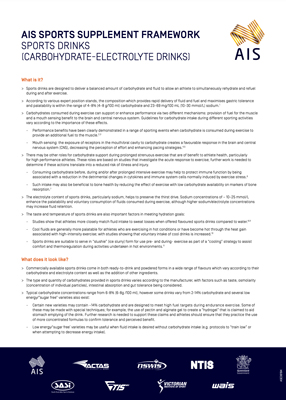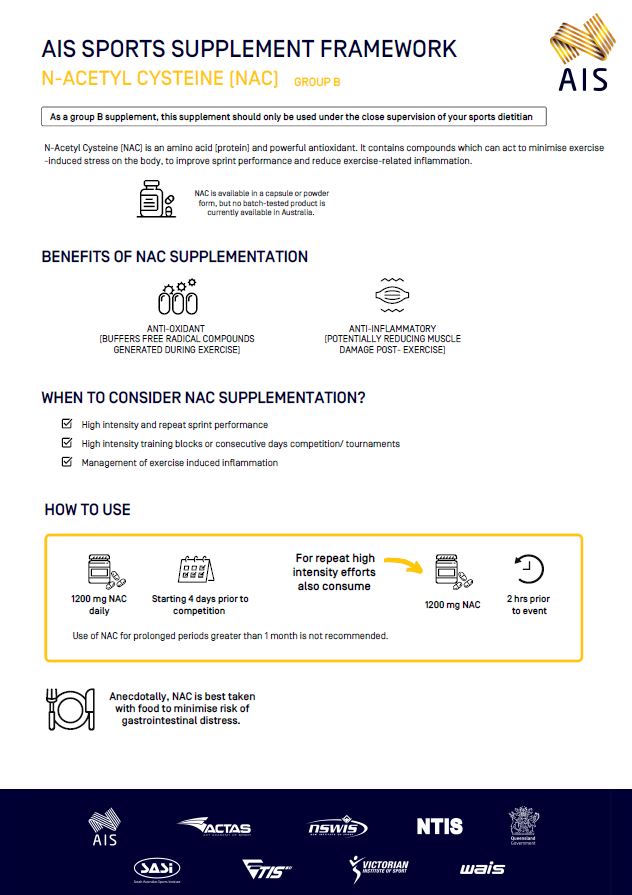N-Acetyl Cysteine
N-Acetylcysteine (NAC)
N-Acetylcysteine (NAC) is an amino acid and powerful antioxidant.

36194_Sport-supplement-fact-sheets-NAC-v3.pdf

Athlete infographics have been developed for the information of athletes under the direct guidance of a sports dietitian. Sports dietitians have expert knowledge of sports supplements and their potential application in an athletes broader health and performance nutrition strategies. Always engage with a sports dietitian when considering the use of any supplement. https://www.sportsdietitians.com.au/#find-sports-dietitian, opens in a new tab
N-Acetylcysteine (NAC) is an amino acid and powerful antioxidant. It is a thiol containing compound that acts to minimise exercise-induced oxidative stress through its actions as a cysteine donor in the maintenance of glutathione homeostasis and via direct scavenging of reactive oxygen species. There are two ways in which NAC supplementation may support athlete performance, as described below:
- NAC as an ergogenic aid to improve high intensity and repeat sprint performance
- An accumulation of oxidants can interfere with skeletal muscle contraction1
- There is evidence suggesting that oral NAC supplementation may help to scavenge or ‘buffer’ oxidants and enable muscle contraction to continue during intense exercise2-4
- NAC to reduce exercise-induced inflammation
- NAC has been shown to support athlete health during periods of intensified training2 and tournaments3
- Promotes the up-regulation of anti-inflammatory cytokines and minimises skeletal muscle injury following fatiguing contractile activity5
- NAC is available in a capsule or powder form but no batched product is currently available in Australia.
- Please refer to Table 1 for suggested supplementation protocols for the different situations that NAC can be used.
- Anecdotally, NAC is best taken with food to minimise risk of gastrointestinal distress.
Table 1: NAC supplementation protocols >
Target event or training | Dose | Protocol | Further information |
|---|---|---|---|
Repeat high intensity efforts/ intensified training period or tournament | 1200mg | Begin supplementation 4 days prior to competition. Additional dose 2h prior to event. | Consider a dose relative to body weight of 70mg/kg for athletes that are below 50kg or above 80kg. Use of NAC for prolonged periods (> 1 month) is not recommended. |
Ergogenic aid | 1200mg | Chronic loading period for 4 days prior to competition. Additional dose 2h prior to event. | Consider a dose relative to body weight of 70mg/kg for athletes that are below 50kg or above 80kg. |
Minimise exerciseinduced inflammation | 1200mg | Begin supplementation 4 days prior to the intensified training period or tournament. Take daily. | Use of NAC for prolonged periods (> 1 month) is not recommended. |
Current use of antioxidant supplements
Mega dosing with exogenous antioxidants can potentially inhibit adaptations to exercise.6 It is important to establish an athlete’s current use of antioxidant supplements and consider ceasing when supplementing with NAC for prolonged periods (i.e., during training camps).
Side effects of NAC
Several unwanted side effects have been reported with the use of NAC. It is recommended that when using NAC, athletes are educated on the potential side effects and complete the questionnaire below daily to track and manage any occurrences (Figure 1). If side effects do occur, quercetin may be used as an effective alternative during periods of intensified training or altitude camps. However, other ergogenic aids (i.e., bicarbonate, caffeine) should be considered if NAC is being used for acute performance benefits.
Figure 1: N-Acetyl Cysteine Health Questionnaire
Please grade any reactions that you experience following consumption of the supplement. Mark only one square.
None | Mild | Moderate | Severe | |
|---|---|---|---|---|
Upset stomach | ||||
Nausea | ||||
Stomach or Intestinal gas | ||||
Metallic taste | ||||
Light-headedness | ||||
Redness of the eye, face or hand | ||||
Welts | ||||
Other (describe) |
Habitual use is not recommended
NAC is not recommended for habitual use. Rather, an increased dietary intake of antioxidant rich foods should be used to improve the oxidantantioxidant balance in athletes.
Supplement safety information and batch tested product list Supplements in sport | Sport Integrity Australia, opens in a new tab
- Cobley, J. N., McGlory, C., Morton, J. P., & Close, G. L. (2011). N-Acetylcysteine Attenuates Fatigue Following Repeated-Bouts of Intermittent Exercise: Practical Implications for Tournament Situations. Int J Sport Nutr Exerc Metab.
- Merry, T. L., & Ristow, M. (2016). Do antioxidant supplements interfere with skeletal muscle adaptation to exercise training? J Physiol, 594(18), 5135-5147.
- Pinheiro, C. H., Vitzel, K. F., & Curi, R. (2012). Effect of N-acetylcysteine on markers of skeletal muscle injury after fatiguing contractile activity. Scand J Med Sci Sports, 22(1), 24-33.
- Reid, M. B., Stokic, D. S., Koch, S. M., Khawli, F. A., & Leis, A. A. (1994). N-acetylcysteine inhibits muscle fatigue in humans. The Journal of Clinical Investigation, 94(6), 2468-2474.
- Rhodes, K. M., Baker, D. F., Smith, B. T., & Braakhuis, A. J. (2019). Acute Effect of Oral N-Acetylcysteine on Muscle Soreness and Exercise Performance in Semi-Elite Rugby Players. J Diet Suppl, 16(4), 443-453.
- Slattery, K. M., Dascombe, B., Wallace, L. K., Bentley, D. J., & Coutts, A. J. (2014). Effect of N-acetylcysteine on cycling performance after intensified training. Med Sci Sports Exerc, 46(6), 1114-1123.